Summary and Rating: JBL Charge 5 vs Flip 6
JBL Charge 5
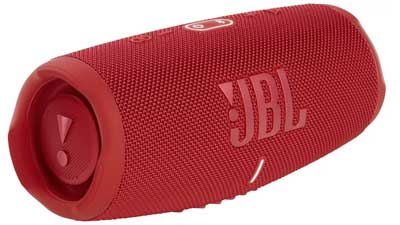
Check Price:
JBL Flip 6
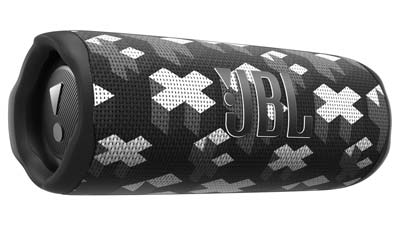
Check Price:
JBL Charge 5
Our Rating – 4.7 (out of five)
IP67 Rating
Battery Life: 19 hrs 5 minutes (tested)
Frequency Response – 60 Hz – 20 kHz
Weight: 960g
Dimensions: 220 x 96 x 93mm
JBL Flip 6
Our Rating – 4.6 (out of five)
IP67 Rating
Battery Life: 9 hrs 40 minutes (tested)
Frequency Response – 65 Hz – 20 kHz
Weight: 540 g
Dimensions: 180 X 69 X 74mm
Pros – JBL Charge 5
- IP67 rating, can handle exposure to dust, sand, and saltwater without damage
- Can double as a powerbank, allowing you to charge other devices, making it extremely useful for outdoor activities.
- Commendable audio experience for the price.
- Provides slightly more bass (extends to 60 Hz) and more wattage than the Flip 6
- Offers about twice the battery life compared to the Flip 6, with approximately 20 hours of playback time
- Wi-Fi Connectivity (Wi-Fi Version): Apart from Bluetooth 5.1, it can connect via Wi-Fi to Apple AirPlay, Alexa Multi-Room Music, Chromecast built-in, and Spotify Connect for a higher quality feed.
Pros – JBL Flip 6
- IP67 rating, can handle exposure to dust, sand, and saltwater without damage
- Commendable audio experience for the price
- Portable and lightweight design
Cons – JBL Charge 5
- Costs more than the Flip 6 due to additional features like longer battery life and the ability to charge devices.
- More substantial in size and weight (960 grams for the standard version)
- Frequency response does not include sub-bass (below 60 Hz)
Cons – JBL Flip 6
- Limited battery life compared to the competition
- Frequency response does not include sub-bass (below 65 Hz)
Bottom Line:
Both speakers are reliable, budget-friendly, durable options in the portable Bluetooth speaker market. The Charge 5 has the edge over the Flip 6 with its ability to double as a power bank and charge other devices.
Introducing the JBL Charge 5 and Flip 6
JBL offers the market’s most popular waterproof Bluetooth speakers, now available in a vast array of shapes, sizes, and colors to cater to every rugged portable speaker need.
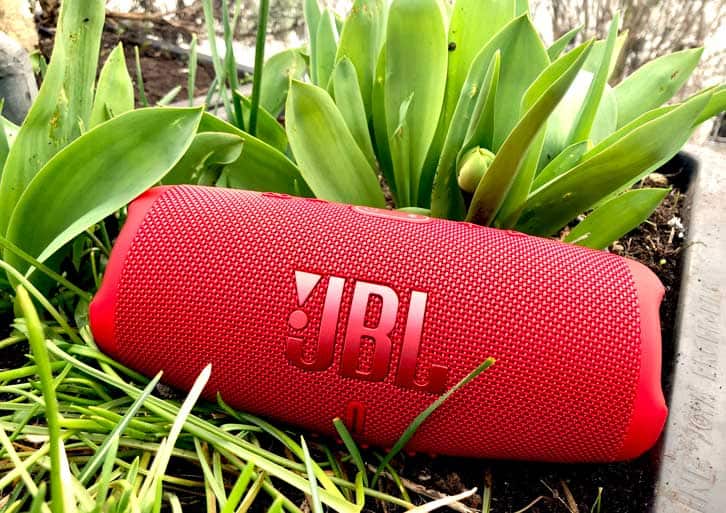
The Flip 6 offers maximum portability, decent sound, and an IP67 water and dust protection rating, at a very affordable price. The Charge 5 offers all of the above as well as twice the battery life and the ability to double as a power bank to charge other devices at a slightly higher price.
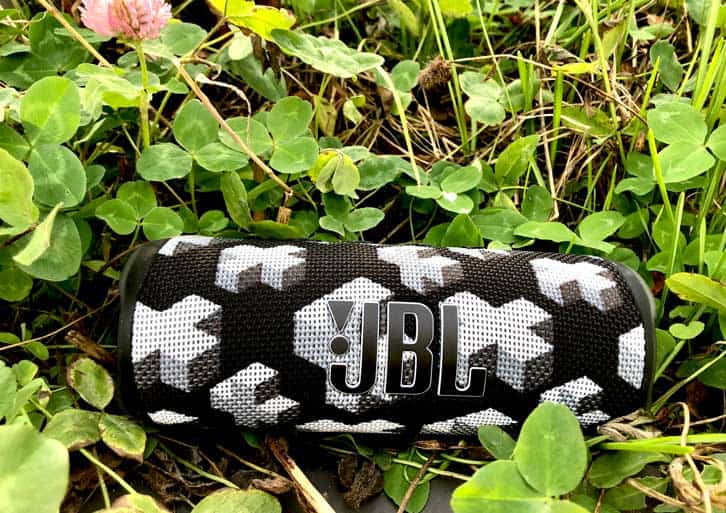
We got our hands on two of these: the Charge 5 and Flip 6, and tested them thoroughly with the competition to see how they match up and if they are worth buying.
See here for all of our bluetooth speaker and other audio gear reviews.
Alternatives to the JBL Flip 5 & Flip 6
JBL Charge 5 Wifi
The Wifi model of the Charge 5 allows for greater flexibility and higher quality audio streaming.
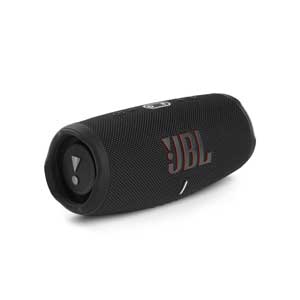
Check Price:
Bose SoundLink Revolve (Series II)
Our favorite sound from a portable Bluetooth speaker, IP55-rated.
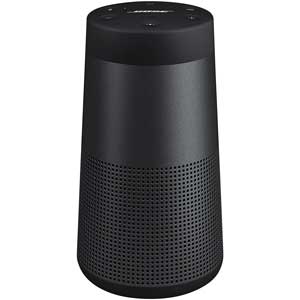
Check Price:
Bose SoundLink Flex
Similar size and sound to the Flip 5 and 6, IP67-rated
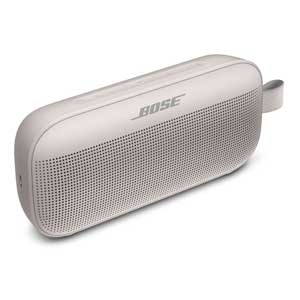
Check Price:
JBL Boombox 3
A larger, more powerful speaker than the Charge 5 and Flip 6. Increased bass extension. (see our complete review of the JBL Boombox 3)
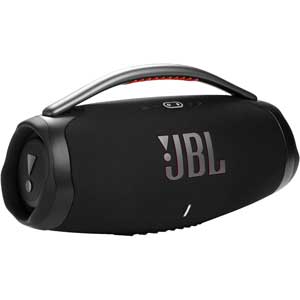
Check Price:
Bang & Olufsen Beosound Explore
Great price, good sound, excellent battery life. IP67-rated
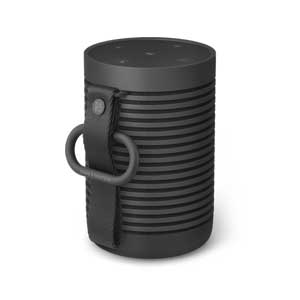
Check Price:
Sound Quality
The audio output of both the Flip 6 and Charge 5 is commendable, especially when considering the price and durability of both speakers. Both speakers give you an enjoyable listen in difficult acoustic environments. We found them to be especially effective with hip-hop, pop, and other groove-heavy genres.
The Charge has a slight edge when it comes to sound quality. As the Flip 6 bottoms out at 65 Hz, the Charge 5 extends to 60 Hz, meaning you’re getting a tiny bit more bass with the Charge 5.
The Charge 5 also has a bit more wattage than the Flip 6. This efficiency roughly translates to a bit more volume.
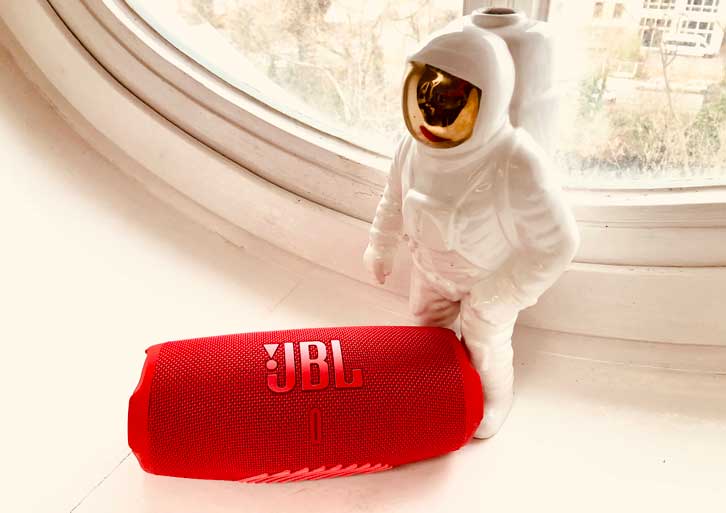
In practice, we tried both speakers on a public basketball court. The Charge 5 had a significant edge on sound quality at high volumes over the Flip 6 with vocals coming through more clearly.
In general, the sound signature of the Flip 6 and Charge 5 can be described as V-shaped. This sound profile gives the listener the best chance of hearing details in the treble while still feeling the groove in challenging acoustic environments.
If sound quality is your priority and you’re listening indoors only, our favorite bluetooth speaker is the Bose SoundLink Revolve (Series II). Although the JBL Flip and Charge speakers deliver reliable audio performance and significant volume, especially considering their size, they are designed to work in environments with acoustic compromises such as beaches or worksites.
This means that the slow-traveling soundwaves of the sub-bass, the lowest range of human hearing, from 20 Hz – 65 Hz (the bottom 20 keys on a standard keyboard), will be absent with these speakers.
All of the popular waterproof Bluetooth speakers that compete with the JBL Flip 5 and Flip 6 have similar outputs, with the lowest bass response going no lower than 55 Hz, as you can see in the table below.
Frequency Response of Portable Bluetooth Speakers Compared
| Model | Frequency Response |
| JBL Flip 5 and Flip 6 | 65 Hz – 20 kHz |
| JBL Charge | 60 Hz – 20 kHz |
| Bose SoundLink Revolve | 60 Hz – 20 kHz |
| Bose SoundLink Flex | 60 Hz – 20 kHz |
| Bang & Olufsen Beosound Explore | 56 Hz – 20 kHz |
| Bang & Olufsen Beosound A1 | 55 Hz – 20 kHz |
Build/Design
The JBL Flip 6 and its predecessors like the Flip 5 (see here for a direct comparison of the JBL Flip 5 and Flip 6) maintain a cylindrical shape, echoing the design language of earlier Flip models. With each weighing approximately 540 grams and stretching slightly longer than a pencil, these speakers epitomize portability.
The Flip speakers are easy to carry and fit seamlessly into most bags or carrying cases. To make sure you know that they are portable, the Flip speakers even have a nylon tie string so you can hang it from the nearest tree.
On the other hand, the Charge 5 series, including the standard and Wi-Fi versions, embraces a slightly larger, heftier build for a good reason. Weighing 960 grams for the standard and 1 kg for the Wi-Fi version, these speakers are notably larger than the Flip series.
This size and weight increase translate to a dual role for the Charge 5—it doubles as a power bank. (Hence the name, Charge!) This unique feature is a boon for outdoor enthusiasts who might need to recharge their devices without sacrificing music playtime.
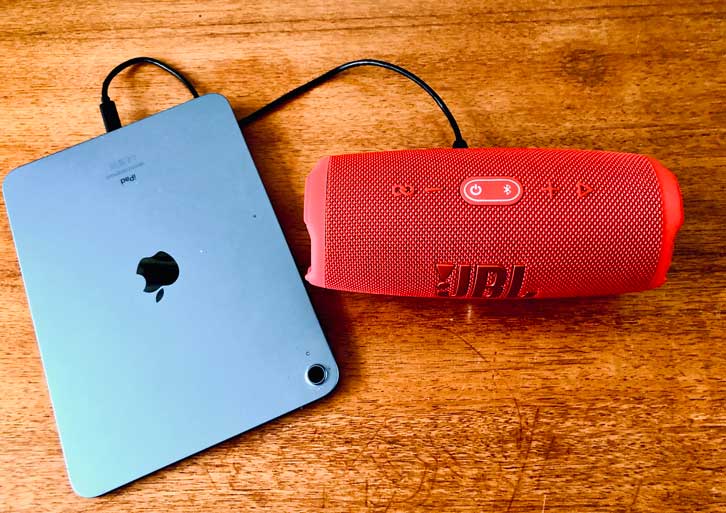
Other than the size difference, the speakers look very similar. The Flip and Charge speakers are wrapped in durable fabric casing with robust rubber ends that serve to protect the exposed bass radiators.
Maybe the best part of the design is watching the bumping radiators as they move in and out with your pumping bass at the ends.
Controls and Connectivity
On the rear side of the speakers, users will find the power and Bluetooth pairing buttons. These buttons are surrounded by illuminating lights, signaling when the speaker is powered on and connected to a device.
The latest models, the Charge 5 and Flip 6, are not ‘smart speakers’. All connections and controls are manually handled with the onboard buttons or using your device.
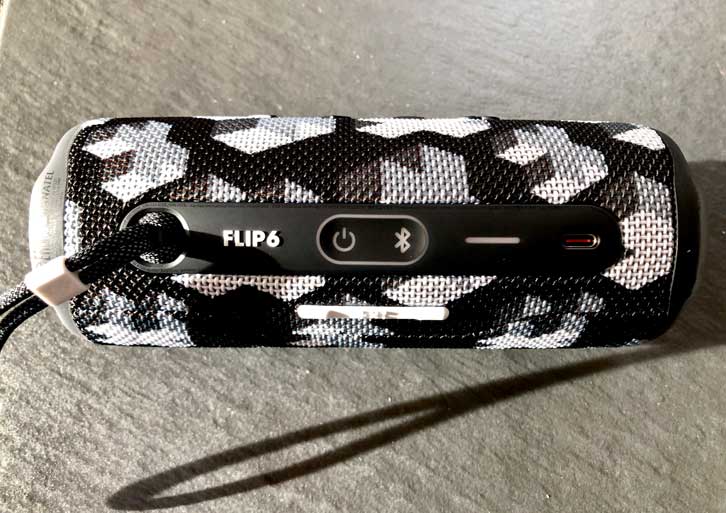
The Charge 5 and Flip 6 speakers use Bluetooth 5.1 and do not support high-quality Bluetooth codecs (only AAC and SBC). Since the speakers are designed for outdoor use and portability, high-quality codecs are unlikely a large concern.
That said, you can get a higher quality feed using Wi-Fi on the Charge 5 Wi-Fi model. In addition to Bluetooth 5.1 connectivity, the Charge 5 Wifi can be connected to Apple AirPlay, Alexa Multi-Room Music, Chromecast built-in, and Spotify Connect.
In our tests, the Flip 5, Flip 6, Charge 5, and Charge 5 Wifi connected to Android and IOS devices with ease and without any drops.
Dust and Water Resistance
The latest Flip and Charge speakers hold an IP67 rating, which means the speakers are not only waterproof but dustproof.
This kind of durability is no small feat. Being completely dust-tight, both models can handle drywall dust, sand, and saltwater without damage. Just hose them down afterward and they are as good as new.
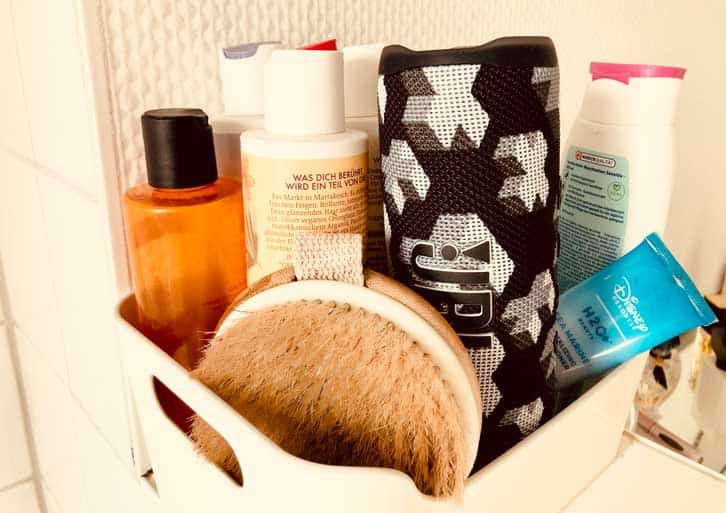
As far as water goes, they can be submerged underwater up to 1 meter deep for 30 minutes, with no problem. Keep in mind, that they don’t float!
Another important note: the USB-C port on both models has no cover. It must be completely dried out before charging.
What is an IP Rating?
Terms like ‘waterproof’ or ‘dustproof’ can mean a lot of things. To clarify what a manufacturer means when they use such terms, the IEC (International Electrotechnical Commission) created the IP code or Ingress protection code.
IP ratings typically have IP followed by two numbers. The first number indicates the level of protection against solids, ranging from larger solids (like fingers) to smaller solids (like dust ). The solid range is from 0-6, 0 being no protection, and 6 being dust-tight.
The second number indicates the level of protection against liquids, ranging from drops of water to full immersion and high-pressure water jets. The liquid range is 0-9.
An ‘X’ indicates that there is insufficient data for that category. For example, IPX7 means the device is not dustproof, but it is level 7 waterproof.
(Level 7 means the device can be submerged in water up to 1 meter deep. Levels 8 and 9 go further, with protection under deeper waters or against high pressure water jets)
Battery Life
In terms of battery life, the Charge 5 offers about twice as much time as the Flip 6.
JBLs claims the Flip 6 battery will last 12 hours on continuous playback and the Charge 5, 20 hours.
In our tests, with the speakers at half volume on continuous playback, the Charge 5 gave us 19 hours, and 5 minutes and the Flip 6 gave us about half that lasting 9 hours and 40 minutes before shutting down.
In everyday use, this means the Flip 6 will make it through one day of use in most cases but you may need a top-up charge with heavy use. The Charge on the other hand will easily last all day without a charge and it will serve as a power bank for your other devices.
Neither of these speakers offer quick charging. Both speakers charge via USB-C with an empty-to-full charge time of 2.5 hours for the Flip 6 and 4 hours for the Charge 5.
Compared with other small Bluetooth speakers on the market, the Charge 5 ranks well while the Flip 6 offers less than the competition.
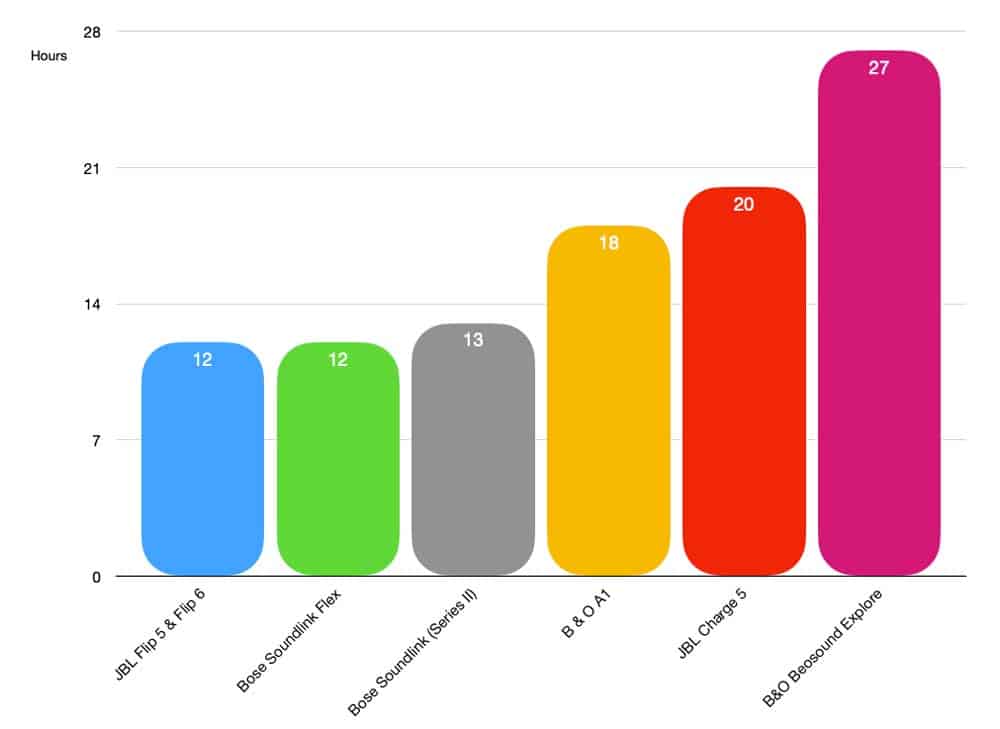
We can see in the chart above that the Charge 5 ranks second only to the B&O Beosound Explore leads the pack with 27 hours. Meanwhile, JBL Flip 6 is second to last, tied with the Bose Soundlink Flex for the least amount of total playback time.
JBL Portable App
The JBL Portable App (previously JBL Connect) allows you to update the firmware of your boombox, adjust EQ, and check the remaining battery life. We tested it out on Android and IOS and everything worked as it should.
The three-band EQ is sufficient for your needs with these speakers. Given that you’re not dealing with the intricate sounds of hi-fi, especially outdoors, three bands will do.
PartyBoost
Perhaps the most useful feature of the JBL Portable App is the PartyBoost mode. The app allows you to connect the Charge 5 and Flip 6 with other JBL speakers that support this function. You can even create a stereo speaker set-up, with separate left and right channels for each speaker.
Verdict: Which should you Get?
After testing, it was clear that the Charge 5 and Flip 6 hold their ground as reliable, budget-friendly, durable options in the portable Bluetooth speaker market. They share many similarities, including their commendable audio output, V-shaped sound signature, and rugged design.
For better sound performance from a bluetooth speaker, we can recommend the Bose SoundLink Revolve. For more sub-bass response, you might consider a larger, more powerful speaker like the JBL Boombox 3.
That said, we can say with confidence that the JBL Flip 6 and Charge 5 are worth the money. The Charge 5 offers a bit more bang for your buck with the handy option to charge other devices.
JBL Charge 5

Check Price:
JBL Flip 6

Check Price:
FAQ
How do you pair with the JBL Charge 5? How do you pair with the JBL Flip 6?
Press the Bluetooth button on the speaker. You will hear some beeps which means you’ve entered pairing mode. Then select the speaker in the Bluetooth settings of your device. Done.
Does the JBL Flip 6 have a microphone?
No.
Does the JBL Charge 5 or Flip 6 support AAC, AptX, or LDAC?
No. Neither the Flip 5 nor the Flip 6 support any of the high-quality Bluetooth codecs. The Charge 5 Wifi, however, can be connected to Apple AirPlay, Alexa Multi-Room Music, Chromecast built-in, and Spotify Connect for higher quality streaming.
Questions or Comments?
Follow the discussion here on Facebook.